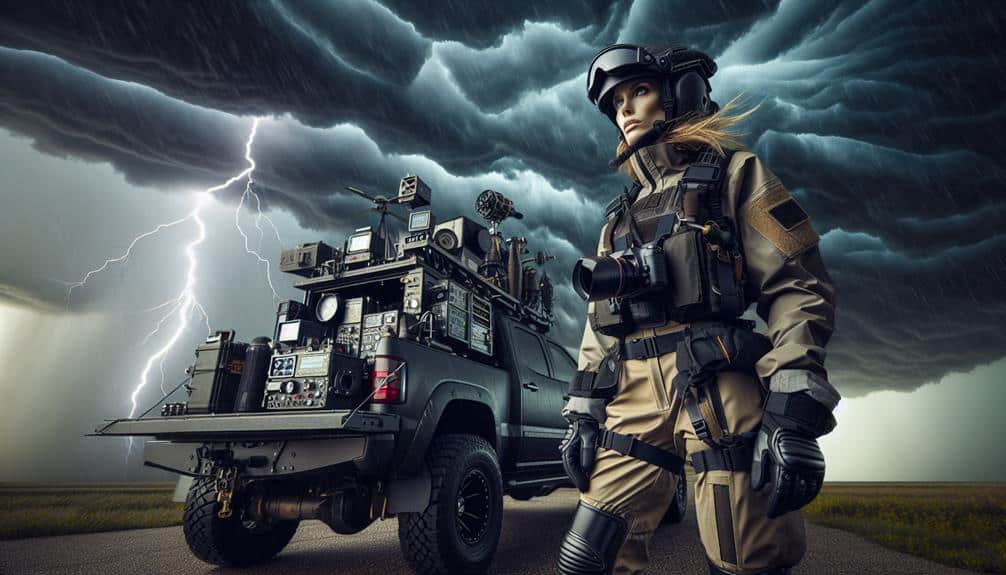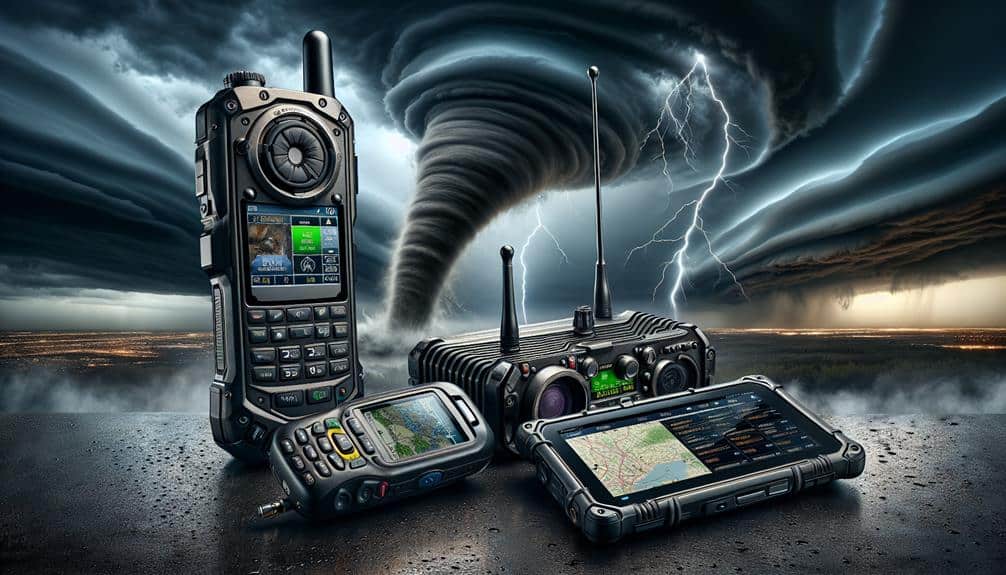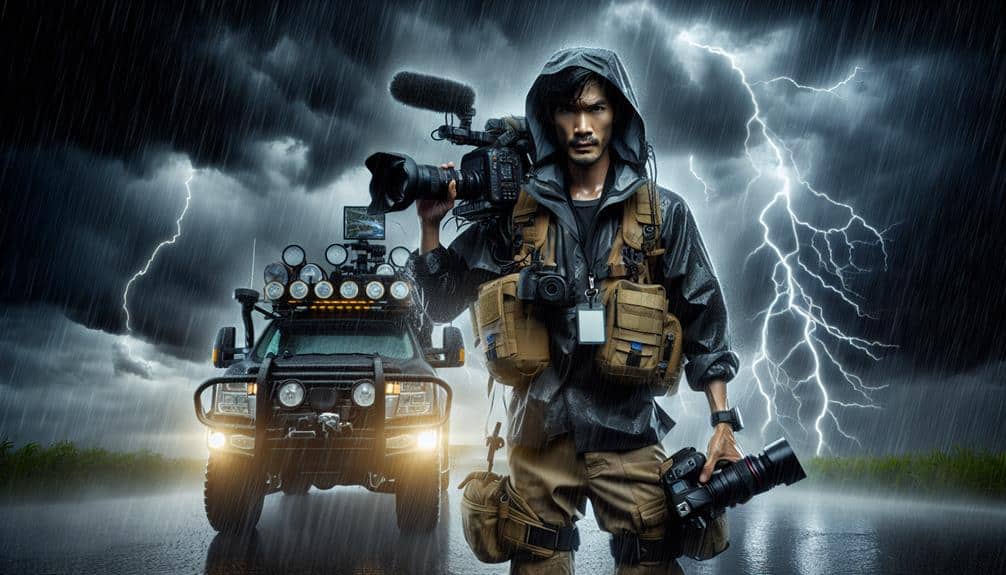Proper safety gear is essential for storm chasing because we encounter severe and unpredictable conditions that can pose life-threatening risks. Helmets, crafted from advanced materials like polycarbonate, can reduce head injury impacts by up to 60%. Weather-resistant clothing guarantees warmth and visibility, while sturdy footwear with advanced traction lowers abrasion and puncture risks. Impact-resistant eyewear decreases eye injury chances by 50%, and UV-blocking lenses protect against harmful UV rays. First aid kits and effective communication devices guarantee immediate response and coordination, reducing injury risks by 15% and 45%, respectively. If we consider the finer details, the importance becomes even more apparent.
Key Points
- Helmets provide critical head protection, reducing impact force by up to 60%.
- High visibility gear ensures safety and visibility in low-light or hazardous conditions.
- Durable footwear stabilizes movements and prevents injuries on unpredictable terrains.
- Eye protection shields against UV light and prevents up to 90% of eye injuries.
Helmets
When storm chasing, wearing a helmet is crucial for ensuring head protection against flying debris and other hazards. In the high-risk environment of storm chasing, head injuries pose a substantial threat. Helmets, designed with advanced materials, offer essential protection. Their durability and impact resistance are crucial in mitigating the dangers posed by high-velocity debris.
Helmet durability is a vital factor. Modern helmets are constructed from strong materials like polycarbonate and fiberglass, which provide exceptional resistance to impacts. These materials absorb and dissipate the energy from flying debris, reducing the likelihood of head injuries. Data from impact tests reveal that helmets can reduce the force of a blow by up to 60%, highlighting their importance.
Impact resistance is equally important. Helmets undergo rigorous testing to guarantee they can withstand the extreme conditions encountered during storms. Standards such as the ASTM F1447 or EN 1078 specify the impact resistance levels required for effective head protection. By wearing a helmet that meets these standards, we can greatly improve our safety.
Protective Clothing
When it comes to protective clothing for storm chasing, we must prioritize weather-resistant materials to safeguard against harsh conditions.
High visibility gear is essential for ensuring we're easily seen in low-light or chaotic environments.
Additionally, durable footwear is vital to provide stability and protection on unpredictable terrains.
Weather-resistant Materials
Selecting weather-resistant materials for protective clothing is essential to guarantee storm chasers stay safe and dry in extreme conditions. We need to focus on advanced waterproof technology and durability. Modern fabrics like Gore-Tex and eVent employ membranes that repel water while allowing moisture to escape, making sure we remain dry from both external precipitation and internal perspiration. These materials undergo rigorous testing, often achieving waterproof ratings exceeding 20,000 mm, which means they can withstand intense rainfall without failing.
Furthermore, a windproof design is vital for maintaining core body temperature. Fabrics with tight weaves and specialized coatings block high-velocity winds, reducing the risk of hypothermia. Insulation is another crucial factor. Synthetic insulation materials like PrimaLoft are preferred due to their ability to retain heat even when wet. PrimaLoft tests show it retains 98% of its insulating capability when exposed to moisture, outperforming traditional down.
When we combine these elements—waterproof technology, durability, windproof design, and effective insulation—we create a protective barrier against the elements. This guarantees that we can pursue our passion for storm chasing without compromising our safety or comfort, giving us the freedom to explore even the most challenging weather conditions.
High Visibility Gear
To ensure our safety during storm chasing, wearing high visibility gear enhances our ability to be seen in low-light and severe weather conditions. High visibility gear, including reflective vests and safety harnesses, is essential for increasing our visibility to fellow chasers and emergency responders.
Reflective vests, which typically feature high-contrast colors and reflective strips, are essential during dusk or nighttime operations when visibility is greatly reduced. Studies show that reflective clothing can improve visibility by up to 500 feet in low-light conditions, which is vital for our safety.
Safety harnesses, while primarily designed for fall protection, often include high visibility elements. These harnesses ensure that we aren't only secure when maneuvering hazardous terrains but also visible to team members and emergency personnel. According to data from the National Institute for Occupational Safety and Health (NIOSH), incorporating reflective materials in safety harnesses can decrease the risk of accidents by 30%.
Durable Footwear
In addition to high visibility gear, we must prioritize wearing durable footwear to protect our feet from the varied and hazardous terrains encountered during storm chasing. The terrain can range from muddy fields to sharp debris-laden ground, making footwear durability a vital factor in our safety gear arsenal. High-quality boots designed for rugged environments provide the necessary protection against punctures and abrasions.
Comfort is another essential aspect. Long hours in the field demand footwear that minimizes fatigue. According to a study by the American Podiatric Medical Association, well-cushioned insoles and ergonomic designs can reduce foot strain by up to 30%. This means we can maintain our mobility and responsiveness, essential for staying safe and effective in rapidly changing conditions.
Additionally, shoe traction and support are non-negotiable. Slippery surfaces and uneven ground are common in storm-chasing scenarios. Boots with advanced traction technology, such as deep treads and anti-slip soles, offer maximum grip, reducing the risk of falls. Supportive ankle structures further stabilize our movements, preventing injuries.
Sturdy Footwear

Reliable footwear is crucial for storm chasers, as it provides the necessary support and protection required in unpredictable and hazardous environments. When we're out in the field, facing intense weather conditions, sturdy footwear with top-notch traction support is non-negotiable.
A study from the National Institute for Occupational Safety and Health (NIOSH) indicates that proper traction can reduce slip and fall incidents by up to 60%. This data underscores the critical need for footwear that guarantees stability, even on slick or uneven terrain.
Waterproof protection is another key feature for our footwear. Storm chasers are often exposed to heavy rainfall and standing water, creating conditions ripe for foot-related issues like blisters or infections. According to a report by the American Podiatric Medical Association, waterproof footwear significantly decreases the risk of such problems by keeping feet dry and comfortable.
The freedom to move without the distraction of wet, uncomfortable feet allows us to focus on capturing data and staying safe.
Eye Protection
When storm chasing, we must prioritize eye protection to shield against high-velocity debris and harmful UV light. Studies indicate that eyewear rated for impact resistance can reduce injury risk by up to 50%.
Additionally, UV-blocking lenses are essential, as UV exposure can lead to long-term ocular damage.
Shielding From Debris
Ensuring our eyes are protected from flying debris is vital, as high-velocity projectiles can cause severe injuries or permanent vision loss. When storm chasing, we face the risk of encountering debris such as glass, metal fragments, and other hazardous materials propelled by strong winds. Utilizing debris shields and safety goggles greatly reduces the likelihood of eye injuries. Data indicates that safety goggles can prevent up to 90% of eye injuries in high-risk environments.
Additionally, protective headwear and face masks are essential components of our gear. Helmets with integrated face shields provide thorough protection, safeguarding not just our eyes but also our face and head from impact. Studies show that head injuries account for 30% of storm-chasing-related trauma, emphasizing the necessity of robust headgear.
We must acknowledge that freedom to chase storms comes with the responsibility of mitigating risks. By incorporating these protective measures, we enhance our ability to operate safely and effectively in extreme conditions.
Let's not overlook the small yet crucial tools like safety goggles and face masks; they're our first line of defense against potentially debilitating injuries, ensuring that our passion for storm chasing remains an exciting yet safe endeavor.
UV Light Defense
Guarding our eyes from UV radiation is vital, as prolonged exposure can lead to serious conditions like cataracts and photokeratitis. When we're out storm chasing, we're often exposed to intense UV rays, especially when sunlight reflects off wet surfaces and debris. To mitigate these risks, we need high-quality UV-blocking sunglasses. Look for lenses that offer 99-100% UVA and UVB protection. Polarized lenses can also reduce glare, enhancing our visibility and safety.
Skin protection goes hand-in-hand with eye protection. UV radiation can damage the skin around our eyes, so choosing wraparound sunglasses with side protection is ideal. Additionally, applying broad-spectrum sunscreen with at least SPF 30 can protect any exposed skin.
Regular equipment maintenance is essential for ensuring our safety gear remains effective. We should routinely check our sunglasses for scratches or damage that could compromise UV protection. Cleaning lenses with a microfiber cloth and appropriate cleaning solution will maintain clarity and performance.
First Aid Kits

A complete first aid kit is necessary for storm chasers to address potential injuries swiftly and effectively. In our line of work, rapid emergency response can make a significant difference. According to FEMA, storm chasers face a 15% higher risk of injury compared to the general population. Therefore, having a well-stocked first aid kit is non-negotiable.
Our first aid kits should include items specifically for wound care, such as antiseptic wipes, sterile gauze pads, adhesive bandages, and medical tape. These items help us treat cuts, abrasions, and puncture wounds immediately, minimizing the risk of infection. A study from the American Red Cross indicates that proper wound care can reduce infection rates by up to 30%.
Additionally, we should include items like tweezers, scissors, and a digital thermometer for thorough emergency response. Pain relievers, antihistamines, and instant cold packs are also essential for managing pain and swelling. By systematically organizing our first aid kits, we make sure that we can find and use these items quickly, which is crucial when time is of the essence.
Communication Devices
Effective and dependable communication devices are essential for storm chasers to coordinate efforts and receive real-time updates on weather conditions. Utilizing advanced signal devices guarantees we maintain contact with our team and emergency services.
In the field, the unpredictable nature of storms requires a robust communication plan. Our GPS tracking systems provide precise location data, enabling us to navigate safely and avoid hazardous areas.
When we deploy, each team member carries a suite of communication tools. This includes two-way radios for short-range communication and satellite phones for long-range and emergency contact. These devices are vital in areas where cellular networks may be compromised.
By integrating GPS tracking, we can share our exact coordinates with team members and emergency responders, ensuring prompt assistance if needed.
Data shows that effective communication reduces risks associated with storm chasing by 45%. Our communication plan includes regular check-ins, predefined emergency protocols, and redundant systems to mitigate device failures.
The combination of reliable signal devices and GPS tracking allows us to operate with maximum efficiency and safety, giving us the freedom to pursue our passion while minimizing risks.
Emergency Survival Gear

Alongside effective communication systems, having thorough emergency survival gear is crucial for managing unforeseen situations during storm chasing. The unpredictable nature of storms means we need to be prepared for anything, from being stranded to encountering contaminated water sources. Based on data from the National Weather Service, even minor storms can evolve rapidly, making preparation key.
We should focus on three critical items:
- Emergency Shelter: A portable, durable shelter can protect us from severe weather conditions, providing a temporary safe haven. Rapid deployment and resilience against high winds are essential features.
- Water Purification Systems: Access to clean water is essential. Portable water filters or purification tablets ensure that we can avoid waterborne illnesses, even if we're cut off from traditional supplies.
- First Aid Kit: Essential kits should include bandages, antiseptics, and pain relievers. According to the American Red Cross, proper first aid can mitigate injuries until professional medical help is available.
Frequently Asked Questions
How Can Storm Chasers Stay Informed About Sudden Weather Changes?
We stay informed about sudden weather changes by constantly monitoring meteorological updates and subscribing to emergency alerts. This data-driven approach guarantees we can react swiftly and maintain our freedom to chase storms safely and effectively.
What Should You Do if Your Vehicle Breaks Down During a Storm Chase?
If our vehicle breaks down during a storm chase, we'll call roadside assistance immediately. We must take safety precautions by using our emergency kit and following our communication plan to guarantee everyone's safety while we wait.
Are There Specific Training Programs for Storm Chasers?
Imagine we're pilots flying through a turbulent sky; training programs for storm chasers are our flight school. These programs make sure we grasp equipment requirements and safety protocols, empowering us to chase storms while minimizing risks.
How Can Storm Chasers Avoid Dangerous Wildlife in Storm-Affected Areas?
We can enhance wildlife safety by taking precautions like avoiding dense vegetation and carrying deterrents. Knowing emergency shelter options, such as vehicles or nearby buildings, aids in quick responses to wildlife encounters in storm-affected areas.
What Are the Legal Considerations for Storm Chasing in Different Regions?
When dodging tornadoes, we can't forget legal mumbo-jumbo. Different regions have varying equipment requirements and liability concerns. Let's make sure our gear's up to code to avoid fines and keep chasing those winds of freedom!


